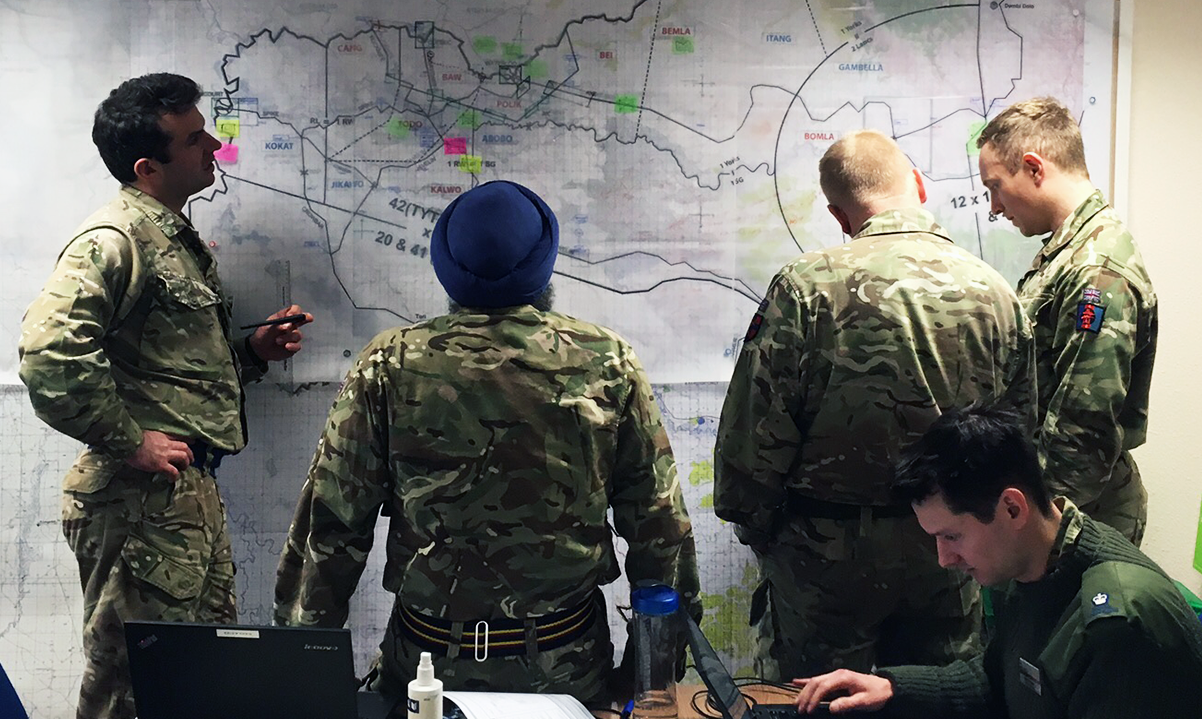Years of campaigning in Afghanistan allowed British military HQs deployed into theatre to increase in size. This increase was both in terms of number of staff in HQs as well as the physical space each HQ occupied. This was a necessary step; counter insurgencies are complex, particularly as they develop. Targeting becomes driven by legal issues. Politicians become more involved and the military finds itself nation building, whilst simultaneously conducting military operations.
Over the course of the Afghan campaign, the British Army re-oriented to face the character of this new conflict. With the British Army’s commitment to combat operations now drawn to a close in Afghanistan, the Army needs to quickly adapt to face the next conflict. It’s not possible to truly predict the characteristics of future conflict, but the Army must be prepared for what it will most likely to face.
Our HQs, at Battle Group, Brigade and Divisional level are too big and cumbersome to be effective in contemporary environment against a peer or near peer adversary. Our future enemies may well be able to coordinate mass fires against us, in a short timeframe. Informed by observations on operations in the Ukraine, lecturers at staff college are suggesting that these timelines could be as short as 8-15 minutes, from sensor acquisition to impact from mass fires. Currently most Field Army HQs are still centered on a packet of vehicles grouped together by tents. Experience would suggest, that even with modern drash-tentage, the quickest these can be established or dismantled is 20 minutes. The implication of this is obvious and exacerbated by the reality that most Step-up HQs constitute only a skeleton of the Main variant. Having a fully equipped Alternate HQ seems to have become a thing of the past.
Concealment of the HQ will be progressively difficult. With an increasing ubiquity and ease of use of modern sensor technologies we must expect to be acquired rapidly on the battlefield; the spectrum of capabilities on offer to an adversary is now baffling. Once found, the HQ can expect to be targeted; with C2 high on the adversary’s priority target list. The solution to this must be to move quickly and to enhance the deception of our adversaries. HQ locations must be indistinguishable from other units, making it difficult for the adversary to distinguish between them and subsequently target. We must obfuscate across all domains and consider the threats not just in the physical, but across the Cyber and Electromagnetic spectrum. This will require novel solutions, such as the employment of unmanned vehicles to rebroadcast redundant communications, dummy HQ vehicles and greater mobility of HQ groupings. But most importantly, it’s time to ditch the tents.
HQs in the armoured role must be able to operate solely from within their vehicles. Our planning processes and the means that support them must adapt. Our HQs could be shrunk and simplified. Time at one location will need to be brief. Commanders’ intent and direction should be distributed quickly, before elements of the HQ disperse to continue planning. This could be achieved through low power wireless networks, visible light communications or other discreet communication channels, allowing information to be quickly synced, before HQs then disperse to plan, and return together at a scheduled synchronisation point. Orders could be issued across the network by VOIP over data burst communications in a similar manner to how radio orders were once the status quo. The same approach could be used for light role, airborne or commando forces. Equally a quick set up, short-range wireless or LiFi network could link buildings together, so that forward HQs are less easy to target and ‘distributed by design’. Reachback to a large ‘think tank’ of staff in a safer or better protected area is also a potential option. But for all this to be viable, we must possess a robust and rapidly deployable communications network, capable of operating securely in a congested and contested electromagnetic environment, where we cannot expect superiority.
Development of these concepts require significant resourcing, but will also require experimentation and exploitation. Resourcing development costs money, but experimentation can come cheap. Simulating distributed and dispersed command in the training environment can be easily achieved and may cognitively prepare our Commanders for the future. HQs can develop efficient & simplified processes and train in separate rooms. Forced to only exchanging information at set times, with minimal direction, Commanders will need to trust their staff to supply them with the information they need, with minimal interaction from above. Speed of decision making is key. Information needs to be succinct, simple and packaged so it can be easily transferred in short bursts. HQs must become less dependent on bandwidth hungry approaches, such as VTC, and pass information over voice supported by simple schematics over data. It will take progressive training to encourage HQ staff away from traditional planning at the map table, to distributed planning between small dislocated staff cells. The exercise of formed HQs should involve training for environments with simulated denied communications, and the use of reversionary methods of planning and executing operations. The first change in all of this however, must be our mindset. Through simple training techniques and faith in the principle of Mission Command, HQs can become smaller, more distributed and dislocated. This will increase their survivability against future threats, and allow them to more effectively support their units.
The views expressed within individual posts and media are those of the author and do not reflect any official position or that of the author’s employees or employer. Concerns regarding content should be addressed to the wavellroom through the contact form
Mike
Mike has more than a decade of military experience, including deployment on operations, training and planning.

